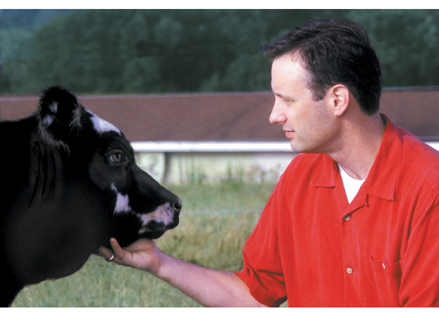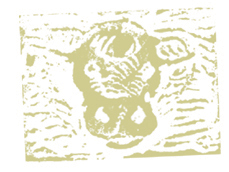


— J.B.P.

Combining advances in livestock cloning with stem cell research offers amazing potential for agriculture, pharmaceuticals and medicine. To realize those promises, though, researchers first must overcome some perils and problems of working on the scientific frontier.
Still in their infancy, cloning and stem cell research are not yet exact sciences.


KC with Steve Stice.
In cloning, for instance, many losses occur before cloned egg cells grow into viable embryos. Problems can occur in late gestation and in the first few weeks of an animal’s life. A recent review of cloning shows that 75 percent of cloned animals are born healthy but 25 percent are lost, said Steve Stice, a faculty member in the University of Georgia animal and dairy science department and a pioneer in livestock cloning.
Clones also may experience early aging or other conditions, such as shorter telomeres on the ends of chromosomes, a condition associated with the aging process.
Laboratory refinements to the cloning process seem to be eliminating some of the early problems. “Cloning is getting more efficient and we’re seeing many reports now showing that telomere shortening is not a problem,” said Stice, who has successfully cloned calves and pigs in his UGA lab.
Cloned mammals, especially cattle, can be quite large at birth, Stice said. That’s why many arrive by Caesarian delivery.
Newborns may have enlarged umbilical cord arteries and veins. Some have lung or heart problems.
Medical applications of human embryonic stem cells are still in the early stages of development, but scientists recognize potential risks, such as rejection of transplanted tissues.
“Our bodies are good at rejecting foreign organisms, cells and tissues,” said Stice, who collaborates with other researchers in developing a treatment for Parkinson’s disease. The treatment is based on growing human stem cells into nerve cells that could be implanted in the brain.
Cells transplanted into the brain are much less susceptible to rejection than in other organs because of the blood/brain barrier, he said.
Rejection may become less of an issue in the future for other organs as well. As scientists forge ahead in stem cell research, they get better at finding and then inactivating genes, such as those in pigs that contribute to organ rejection in humans. Scientists are now figuring out how to grow uniform cell populations and eliminate undesirable side effects of stem cell therapies, such as the source of the tissue and the possibility of tumors.
Despite the perils, cloning and stem cell research promise many possibilities. Among them:
- Cloning livestock to produce better meat with inherited disease resistance; preserve genetic diversity; and develop higher-producing livestock.
- Combining
cloning with transgenics — snipping out unwanted genes or inserting
desirable ones — to produce “pharm” animals that make
pharmaceuticals or tissues such as liver, lung, heart and kidney for
transplants.
- Using stem cells to devise new treatments for diabetes, Parkinson’s, spinal cord injuries and multiple sclerosis.
The problems of stem cell therapies pale in comparison with the hopes for new bioengineered materials and artificial organs that circumvent transplant rejection problems.
For comments or for information please e-mail the editor: jbp@ovpr.uga.edu
To contact the webmaster please email: ovprweb@uga.edu
![]()